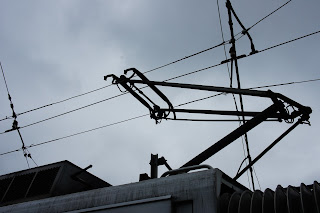 |
Photo uploaded by zaigee on Flickr |
The Hoosac Tunnel is an almost five mile long tunnel that runs from Florida, Massachusetts to North Adams Massachusetts through the Berkshires. It is the longest, still operational, transportation tunnel east of the Rocky Mountains. Today, the tunnel is only used by PanAm Railways which runs freight traffic through the tunnel
The Hoosac Tunnel was first proposed in 1819 as an underground canal beneath the Berkshires as a way of providing a passage way for goods and raw materials between Boston and points west. With the invention of the steam locomotivewthe tunnel plan was re-evaluated and re-proposed for railway traffic. Work officially commenced in 1851 by the Troy and Greenfield Railroad Company. It would take 24 years and $21 Million dollars to complete.
Initially the tunnel was to be constructed using a 70-ton steam-driven boring machine. The machine however seized up on a test run and could not be used for construction. Following this failure, the work was done by means of hand-drills and gunpowder. That was until the invention of nitroglycerine. The nitro proved to be a very powerful and extremely unstable explosive that resulted not only in successfully blasting the length of the tunnel, but also in killing dozens of men in its use.
The tunnel was considered an engineering marvel when it was completed in 1875. Yet, it would cost 195 lives in various fires, explosions, and tunnel collapses, hence earning its name among the crew as the "Bloody Pit". Today, it is also said to be one of the most haunted places in New England.
Ghost Stories
After the accidents began piling up during the construction many workers came to feel that the tunnel was cursed and many of them refused to enter it again. Some of the crew members simply walked off the job and did not return.
1: Murder ?: On the afternoon of March 20, 1865, three explosive experts named Ned Brinkman, Billy Nash and Ringo Kelley decided to use nitroglycerine to continue their work on the tunnel. They placed a charge and then ran back toward a safety bunker that would shield them from the effects of the blast. Brinkman and Nash never made it there however. For some reason, Ringo Kelley set off the charge before the other men could make it to shelter. The two men were buried alive under tons of rock. Soon after the accident, Kelley vanished without a trace, leading many to believe that the "accident" with the nitro may not have been an accident after all. He was not seen until a year later when his body was discovered inside the tunnel. It was found at almost the exact spot where Brinkman and Nash had been killed. The authorities quickly deduced that Kelley had been strangled to death. The death was thoroughly investigated but no suspects were ever found and the crime went unsolved.
2: On October 16, 1874 a local hunter named Frank Webster vanished near Hoosac Mountain. Three days later, he was found by a search party, stumbling along the banks of the Deerfield River. He was in a state of shock, mumbling incoherently and falling down. He explained to his rescuers that strange voices had ordered him into the Hoosac Tunnel and once he was inside, he saw ghostly figures wandering around. He also said that invisible hands had snatched his hunting rifle away from him and that he had been beaten with it. He couldn’t remember leaving the tunnel. Members of the search party recalled that Webster did not have his rifle when he was found and the cuts and abrasions on his head and body did seem to bear evidence of a beating.
3: In 1994 Kevin from Boston reported that while in the old control room opposite the ventilation shaft he heard "whisperings" and a "shape" about three feet tall and completely black staying just outside of the edge of his flashlight beam. "It always stayed just outside the beam about 20 feet distant, I have to conclude it was the light that kept it away from me. What I saw was real and moved with deliberation and I didn't have reason to believe it was friendly."
Locals in the area still claim that strange winds, ghostly apparitions and eerie voices are experienced around and in the daunting tunnel. Some researches have left tape reorders in the tunnel and have reported hearing what seems to be muffled voices when they play back the tape. There is also rumor of a hidden room in the tunnel. The room is said to be bricked up and house unspeakable horror.
HAPPY HALLOWEEN!
























